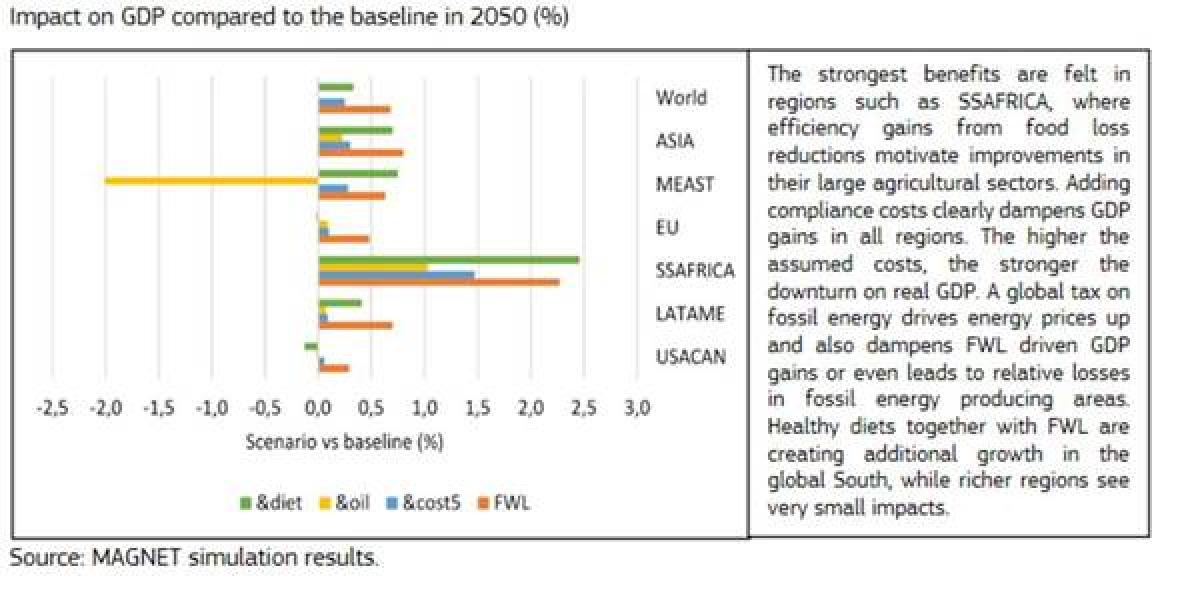Highlights
This study aims at assessing the impact of behavioural changes with regard to food consumption with a focus on the objectives of SDG target 12.3. The first scenario investigate the impact of global food waste and loss (FWL) reductions at different points along the supply chain, implemented by 2030 and maintained until 2050. The remaining scenarios build upon the FWL scenario through four sets of experiments: (i) a dual decomposition of the FWL scenario to examine waste and loss reductions in isolation, (ii), variations in associated food supply chain compliance costs to meet the assumed FWL reduction, (iii), an exploration of the resilience of food demand systems to rising fossil energy prices, and (iv) a transformation toward healthier plant-based diets over the period 2020 to 2050 inspired by the EAT-Lancet report. To facilitate the comparison of the diet scenario and FWL scenarios, the share of red meat, white meat and dairy consumption is kept constant in the baseline and all FWL scenarios.
Due to improved production efficiency in the food chain arising from food loss reductions, global food prices decrease, and therefore lead to a higher food consumption, indicating a positive impact of all scenarios on food affordability. The region-wide reduction in food prices is a significant benefit for the most vulnerable members of society, particularly poor households in developing countries and could thus contribute to reducing food insecurity.
While trade-offs exist and have to be carefully analysed and addressed, the scenarios show a strong positive message regarding the reduction of the environmental impact in the depicted scenarios. The global food footprints are reduced throughout all scenarios for land and emissions, with the FWL scenario combined with a healthy diet having the largest impact. The smaller impact from the FWL scenario on the emissions is due to the strong improvement of productivity and related consumption increase. Water abstraction shows a more mixed picture as it increases in many regions compared to the baseline, with the highest effects relating to the diet shift. While livestock production declines, water-intensive and irrigation-based horticulture production significantly increases.
From a macroeconomic perspective, the results indicate that GDP increases in all regions as a result of the FWL scenario, with strongest relative impacts in regions such as Sub-Saharan Africa, which have a large agricultural sector share of the total GDP and, accordingly, benefit the most from the efficiency gains. Adding the costs associated with of food loss and waste reductions, lowers these GDP gains in all regions. The higher the assumed costs, the stronger the downturn on real GDP, but the extent to which GDP gains reduce varies across regions. Moreover, a global fossil fuel tax drives energy prices up and consequently leads to lower GDP gains or even losses in regions heavily dependent on fossil energy production.
Finally, although beyond the scope of this study, it should be recognised that more sustainable and healthier diets offer additional benefits to biodiversity and related ecosystem services, as well as improved health of the population, greater labour productivity and reductions in associated public health expenditures.


| Geographic coverage | Global |
| Originally published | 18 May 2022 |
| Knowledge service | Metadata | Global Food and Nutrition Security | Sustainable Food Systems | Food systems transformationDietFood loss and wasteFood and nutrition securityFood consumptionAnimal source foodAccess to foodFood systemHealthy diet |
| Digital Europa Thesaurus (DET) | Modellingland useconsumer behaviourreduction of gas emissionsSustainable development goalsImpact Assessment |
